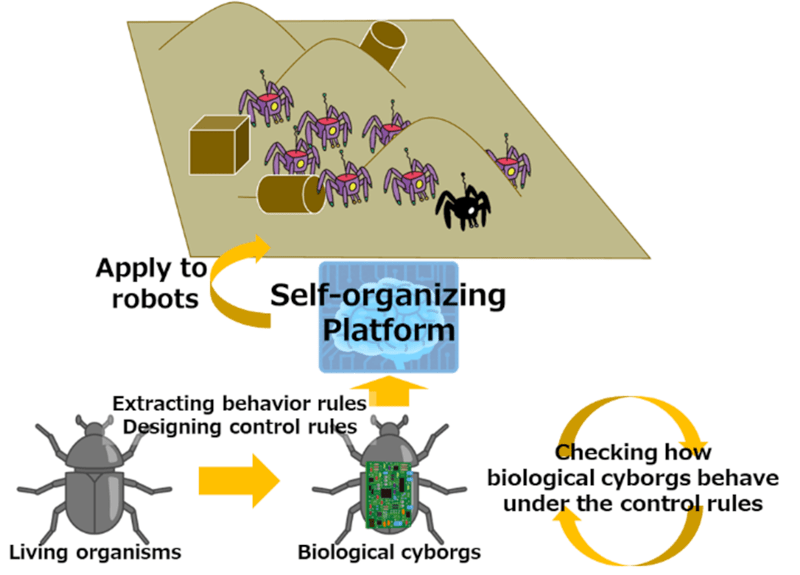Outline of R&D
New World of Inspiration by Co-evolution of Humans, AIRobots, and Biological Cyborgs
1. Position in the program
In the overall efforts of the research program to accelerate and strengthen the development of artificial intelligence (AI) technologies that enable people to change their behavior by gaining awareness from AI robots, this project is positioned as a project for research and development of "AI for emergence of swarm behavior in unknown environments".

Living organisms can adapt their behavior to their environment even while they lack access to accurate environmental information. Through the extraction of the "behavior rule" from these living organisms and the design and implementation of the "control rule," we are developing artificial intelligence (AI) technology in this project that can generate the desired self-organization. We aspire to build a "new world of inspiration" in the future, where people, robots, and biological cyborgs collaborate and co-evolve.
2. Overview of the R&D and the Challenges
The following three R&D themes have been implemented to accomplish the aforementioned objectives.
(1) Biological cyborg swarm development engine
e are developing "biological cyborgs," insects equipped with a board of brain electrodes and other electronic circuits, to extract the "behavior rules" of living organisms and design "control rules." It will be possible to gather data on the organism's perception and behavior as well as information about its surroundings by turning it into a cyborg, which will allow for further manipulation of the organism's perception and behavior. This will enable us to develop a method to induce behaviors (forward movement, rotation, backward movement, left-right movement, etc.) through electrical stimulation via nerve electrodes and environmental changes such as sound, light, and heat.
By using the developed biological cyborgs, it will be possible for the first time to test and improve the model through direct manipulation on the organism's perception and behaviors, unlike conventional methods such as simulations. This will enable us to better model the behaviors (behavior rules) of living organisms.

(2) Self-organization platform
We will develop a "self-organization platform" consisting of AI technology that learns biological behaviors from data obtained through biological cyborgs and extracts behavior rules, and AI technology that designs control rules to generate desired self-organized behavior by inputting additional control to the behavior rules. Furthermore, through its application, we aim to achieve self-organized cooperative work by robots.
The challenge of this R&D is that there is no conventional technique for extracting continuous state and deterministic behavior rules for living organisms. Moreover, conventional techniques develop models under uniform and homogeneous condition settings, which do not reflect reality. Thus, other challenges are that we "target living organisms with extremely large individual differences," "self-organize freely behaving organisms by controlling them," and "execute desired self-organized behaviors and tasks through limited control".
(3) Living vitality
In order to generate self-organization making use of living organisms’ adaptabilities, it is necessary to extract behavior rules that reflect the living vitality, such as pleasure and discomfort of organisms, and design control rules that take this into account. For this purpose, we will establish a method to quantitatively measure the living vitality from the organism's perceptual and behavioral information. Although we fundamentally do not get to know the true emotions of organisms, we construct a situation based on the assumption of pleasure and discomfort for organisms. By measuring the perceptual and behavioral information of the organisms in the situation, and examining the relationship with the environmental factors, we will quantify the living vitality.
3. Future plans
Our goal is to realize self-organized cooperative work in challenging conditions by robot swarm applying behavior and control rules. Furthermore, in 2050, we aim to realize a "new world of inspiration" where people, robots, and biological cyborgs collaborate and co-evolve with each other.